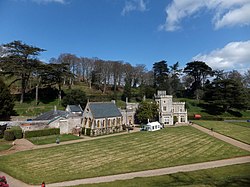| Luscombe Castle | |
|---|---|
 Luscombe Castle | |
 | |
| General information | |
| Type | Stately home |
| Architectural style | Gothic Revival |
| Classification | Grade I listed |
| Location | Dawlish |
| Construction started | 1800 |
| Completed | 1804 |
| Technical details | |
| Material | Stone |
| Design and construction | |
| Architect(s) | John Nash |
| Other designers | Humphry Repton (gardens) |
| Main contractor | John Veitch (gardens) |
Luscombe Castle is a country house situated near the resort town of Dawlish, in the county of Devon in England. Upon purchasing the land at Luscombe in 1797, Charles Hoare demolished the existing house and commissioned architects John Nash and Humphrey Repton to design a new house and gardens at the site. Nash and Repton came up with an asymmetrical designed building made from Portland stone, with castellated parapets, turrets and pinnacles to create the feel of a picturesque castle.
Nash's designs for the house included a three-storey octagonal tower, with two wings coming off it and a second square tower above a porte-cochère. Inside the drawing room occupied the ground floor of the tower, with a sitting room above. The dining room was designed to hold views across the valley, and the asymmetric rooms allowed for a panorama of views. To allow easy access to the gardens, the servant's quarters were moved to a separate wing, but made to be less prominent. A chapel was added in approximately 1862, and the house's loggia was converted into a conservatory.
The grounds were designed by Repton, and laid out by John Veitch. They extend to 140 hectares (350 acres), with 10 hectares (25 acres) of gardens, both formal and informal, and other pleasure grounds, while the remainder covers parks and woodlands. The main garden, known as the American Garden, includes ponds and ornamental shrubs. The house was designated a Grade I listed building and its gardens are also Grade I listed in the National Register of Historic Parks and Gardens.
The site should be distinguished from Luscombe in the parish of Rattery in Devon, about 16 miles to the south-west, the seat of the Luscombe family from before the 16th century[1] to shortly before 1810.[2]
- ^ Vivian, Lt.Col. J.L., (Ed.) The Visitations of the County of Devon: Comprising the Heralds' Visitations of 1531, 1564 & 1620, Exeter, 1895, p.535, pedigree of "Luscombe of Luscombe"
- ^ Risdon, Tristram (d.1640), Survey of Devon, 1811 edition, London, 1811, with 1810 Additions, p.298